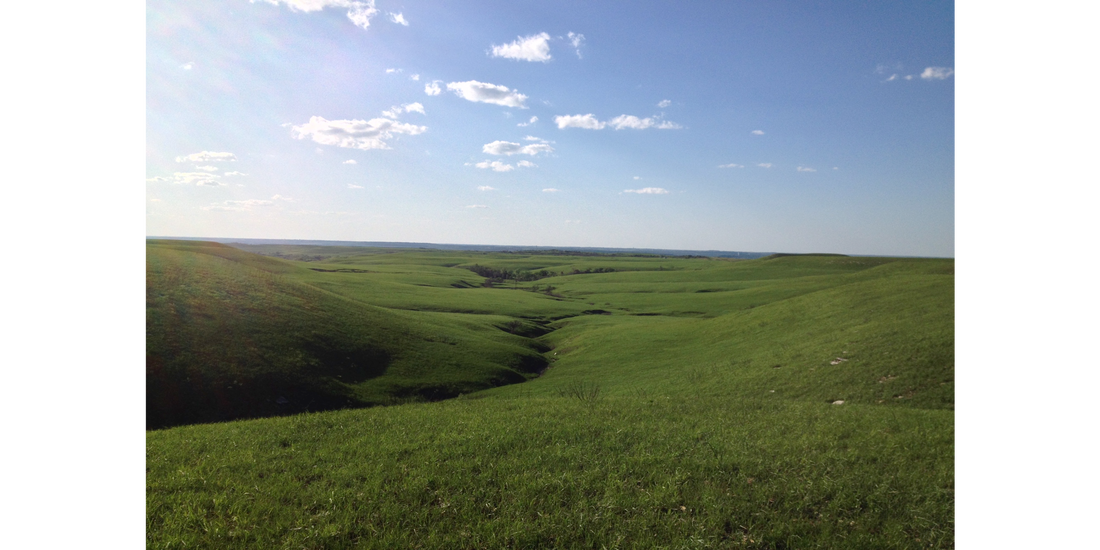
Check out the write-up on the project in Chapman's Newsroom.
-------------------------------------------------------------------------------
 A big shout out to Andrew Felton, who will begin a USDA-NIFA postdoctoral fellowship with us on September 1st. Andrew will work on a project entitled: Optimizing rangeland decision making by unraveling geographic variation in the timing of forage sensitivity to weather. Check out the write-up on the project in Chapman's Newsroom.
0 Comments
A new paper out in the Journal of Microbiology and Biology Education in collaboration with the postdoctoral fellows, faculty and staff from the Grand Challenges Initiative:
The Goldsmith Lab has been awarded the 2019 Ignacio Rodriguez-Iturbe award for an outstanding publication from the journal Ecohydrology for their article quantifying the spatial variation in stable isotopes of water in a forest ecosystem. The research establishes best practices for using stable isotopes of water as a tool for understanding the source of water used by different species of trees in forest ecosystems:
Spatial variation in throughfall, soil, and plant water isotopes in a temperate forest by Gregory R. Goldsmith, Scott T. Allen, Sabine Braun, Nadine Engbersen, Clara R. González‐Quijano, James W. Kirchner, Rolf T.W. Siegwolf The results are part of a long-term collaboration designed to inform the sustainable management of Switzerland’s forests in the face of unprecedented rates of climate change. The project was carried out in collaboration with researchers from the Institute for Applied Plant Biology, the Swiss Federal Institute for Forest, Snow and Landscape Research and ETH Zurich with funding from the Swiss Federal Office of the Environment. Meeting AbstractP30-2 Sat Jan 2 Effects of diffuse light on the physiology, growth, and fruit yield of tomato plants Ellertson, K*; Prakash, A; Goldsmith, G; Berry, ZC; Chapman University ; Chapman University ; Chapman University ; Chapman University
Introduction: We routinely study how the quantity of light affects rates of plant photosynthesis. However, what happens to photosynthesis when we change the angle of light? A growing body of research has demonstrated changes in leaf photosynthesis and net ecosystem exchange in diffuse light conditions caused by clouds or other aerosols. However, our understanding of the effects of diffuse light on physiological processes and the concomitant effects on growth and yield remain limited. Methods: We compared the physiology, growth and yield of tomatoes (Solanum lycopersicum) grown in direct compared to diffuse light conditions. Diffuse light conditions (ca. 50-60% diffuse) were created by a painted glass panel that leads to diffusion of light, but does not significantly reduce the quantity of light. Results: We observed significant differences in photosynthetic function, including water-use efficiency, of plants in diffuse light as compared to direct light conditions. However, there was increased leaf cupping in plants grown in direct light, which may be due to higher temperatures (ca. 3-5 °C) in that treatment. We also observed no differences in initial plant growth (height, leaf number, and stem diameter); however, fruiting in the diffuse light conditions was higher than in direct light conditions. Discussion: Diffuse light conditions may have their greatest impact on plant structure and function by increasing flowering and fruit production. This effect may be mediated not by the light quality, but in this case by the temperature change induced by diffusing the light. As the climate warms, these results suggest that simple modifications to greenhouse structure may benefit fruit yield for key crops. We have a new preprint posted to Edarxiv from the teaching team in the Grand Challenges Initiative at Chapman University:
Discussion can be an important and powerful tool in efforts to build a more diverse, equitable, and inclusive future for STEM. However, facilitating discussions on complex and uncomfortable issues, like racism and sexism, can feel daunting. We outline a series of steps that can be used in offices, laboratories, and classrooms to facilitate productive discussions that empower everyone to listen, contribute, learn, and ultimately act to transform STEM. Read the full text here: FULL TEXT It is feeling like the end of an era in our lab. But so many great things are happening:
Dr. Eleinis Àvila-Lovera has started an Earl S. Tupper Fellowship at Smithsonian Tropical Research Institute in Panama. We continue to collaborate on project funded by a USDA-AFRI grant designed to understand the effects of green stem photosynthesis on hydraulic functioning in avocados. Dr. Scott T. Allen has started a faculty position at the University of Nevada, Reno. We continue to collaborate on a project funded by the Swiss Federal Office of the Environment designed to understand the future of Switzerland's forest ecosystems. Dr. Carter Berry has moved back east to his old haunting grounds in North Carolina. We continue to collaborate on a project funded by a USDA-AFRI grant designed to understand the effects of diffuse light photosynthesis on plant gas exchange. Dr. Andrew Felton joins us from Peter Adler's laboratory at Utah State University. Andrew will bring together our research on wood water storage and satellite remote sensing, funded by grants from USDA-AFRI and NASA. We are so excited to have Andrew as part of our community.  My student Alex Drivas (Biochemistry '21) has been spending part of his summer working on printing aluminum parts using our 3D printer. I encouraged Alex to try this approach because, if successful, it would transform our ability to make new equipment in the lab. Generally, if you need something made of metal, you send a drawing out to a company that uses a CNC mill to remove material from a block of metal until you have the desired shape. This is referred to as subtractive manufacturing. Now, our desktop 3D printers have the ability to print in metal or in plastics supplemented with metal at the click of a mouse. Instead of sending something off to an outside manufacturer and paying hundreds or thousands of dollars per piece, we can print a design in the lab in the matter of hours for just the cost of the printer (< $1000) and the cost of the filament (~$165 per kilo). The print does need to be de-bound and sintered offsite, so it's not instant gratification, but it is a huge step forward. Alex is at the cutting edge of using this technology (a future employer will be very lucky) and I asked him to write up his specifications and thoughts on printing for the benefit of the 3D printing community. Here's what he has to say: General Specifications Hot end: 240 °C Bed temp: 100 °C Layer thickness: 0.2mm Perimeters: 4 count Infill type: Concentric Speed First layer print speed: 25mm/s Print speed: 40mm/s Travel speed: 125mm/s Cooling Fan: off Extrusion/Retraction Extrusion multiplayer: 90% First layer extrusion: 93% Retraction length: 6mm Retraction speed: 125mm/s Adhesion Dimafix 4 count brim Glass plate What I learned: Adhesion and extrusion settings were the most important variables in printing. I had to apply more Dimafix around the corners of the print than the center and introduce a small brim to achieve proper layer adhesion through the print. I had to lower the Z offset (beyond what I would for PLA for ABS) to get better first layer adhesion. In following layers, I manually increased the Z offset just slight. If the nozzle was too far from the plate, the layer would not stick properly, however, if the Z offset was too low, the nozzle would grab material from the print as it extrudes. Improper adhesion would cause the corners of the print to curl and destroy the progress of the print. Applying too much Dimafix however, would make it close to impossible to remove from the bed. Over-extrusion was a second variable adding to the debris build up around the nozzle. It was difficult at first to differentiate between the two. It will vary in printer type, but I narrowed ours down to the extrusion and retraction settings I had stated above. Decreasing the extrusion of the first layer however, made capturing the proper Z offset very important. Even with the successful print, I was still receiving a little over-extrusion and debris build up around the nozzle and had to pause the print to clean the nozzle. The debris did not build up over time, but rather varied based on contours and geometries at the specific stage of the print. The green part coming off the bed is unclean and needs to be sanded and filed to clean up the past troubles with extrusion. In terms of the material and how it physically printed, I would compare it to trying to print clay. Coming out of the hot end, it does not stick to the bed as you would expect. Rather, it sticks to itself at times you don’t want it to and doesn’t when you do. Geometrically the material is very limited. Holes below a 10mm radius print unclean and inconsistent through layers. Thicker walls the better. Any internal fillets or contours are difficult and should be avoided. The optimal print for this material would be a gear or some small, geometrically uncomplex, internally uniform object. Alex's work was supported by a grant from the Center for Undergraduate Excellence at Chapman University. We are fortunate to have a Picarro L2130i cavity ringdown spectrometer in our new lab here in the Keck Center for Science and Engineering here at Chapman University. The instrument can analyze stable isotopes of oxygen and hydrogen in water vapor or liquid samples via the autosampler (with a dry nitrogen carrier gas). The lab has a number of in-house standards that span the range of typical waters at natural abundance. Many labs are not running highly enriched or depleted liquid samples right now due to memory effects; these problems can be solved with a particularly rigorous approach to sample injection and careful choice of standards; we are willing to take the time to run those samples. We are happy to serve as a resource for the community - please reach out if you have analyses in mind. We also have the ability to extract water from environmental samples (e.g. soil, plants, and other biological tissue) using the method proposed by Koeniger et al. (2011 in RCMS). The basic principle is that a sample under vacuum is heated in the dry block heater and the evaporated water is in turn condensed in liquid nitrogen. This approach has not been as widely applied as cryogenic vacuum distillation systems built with glass or metal manifolds; however, the principles of use are identical. Again, we are happy to serve as a resource for the community - please reach out if you have analyses in mind or if you would like the parts list that we developed for how to build this instrumentation.
Folks in the lab are pursuing a number of different innovative projects right now, ranging from understanding how environment contributes to the evolution of new species in the Tropics to how water moves through landscapes. What is interesting is how many of those innovative projects are leaning on very classic methods - we are measuring soil texture, quantifying stem anatomical traits, and counting stomata. Looking forward to seeing the results!
|
Archives
November 2023
Categories
All
|